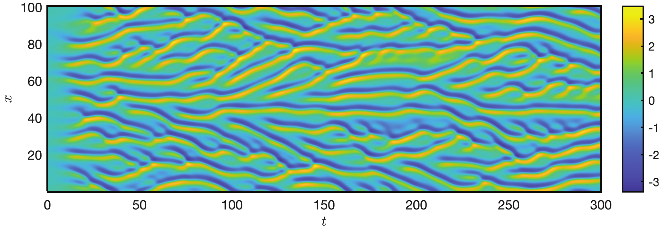PDFLINK |
The Kuramoto–Sivashinky Equation
Communicated by Notices Associate Editor Daniela De Silva
The Kuramoto–Sivashinsky equation
applies to a real-valued function of time and space . This equation was introduced as a simple 1-dimensional model of instabilities in flames, but it turned out to be mathematically fascinating in its own right 7. One reason is that the Kuramoto–Sivashinsky equation is a simple model of Galilean-invariant chaos with an arrow of time.
We say this equation is ‘Galilean invariant’ because the Galilei group, the usual group of symmetries in Newtonian mechanics, acts on the set of its solutions. When space is 1-dimensional, this group is generated by translations in and , reflections in , and Galilei boosts, which are transformations to moving coordinate systems:
Translations act in the obvious way. Spatial reflections act as follows: if is a solution, so is . Galilei boosts act in a more subtle way: if is a solution, so is .
A solution of the Kuramoto–Sivashinsky equation. The variable ranges over the interval with its endpoints identified. Initial data are independent identically distributed random variables, one at each grid point, uniformly distributed in .

We say the Kuramoto–Sivashinsky equation is ‘chaotic’ because the distance between nearby solutions, defined in a suitable way, can grow exponentially, making the long-term behavior of a solution hard to predict in detail 4. And finally, we say this equation has an ‘arrow of time’ because time reversal
is not a symmetry of this equation. Indeed, in Figure 1 we see that starting from random initial conditions, manifestly time-asymmetric patterns emerge. As we move forward in time, it looks as if stripes are born and merge, but never die or split. Attempting to make this precise leads to an interesting conjecture, but first we need some background.
It is common to study solutions of the Kuramoto–Sivashinsky equations that are spatially periodic, so that for some . We can then treat space as a circle, the interval with its endpoints identified. For these spatially periodic solutions, the integral does not change with time. Applying a Galilean transform adds a constant to this integral. In what follows we restrict attention to solutions where this integral is zero. These are roughly the solutions where the stripes are at rest, on average.
We can learn a surprising amount about these solutions by looking at the linearized equation
We can solve this using a Fourier series
where the frequency of the th mode is . We obtain
Thus the th mode grows exponentially with time if and only if , which happens when . As we increase , more and more modes grow exponentially. These appear to be the cause of chaos even in the nonlinear equation. Indeed, all solutions of the Kuramoto–Sivashinsky equation approach an attractive fixed point if is small enough, but as we increase we see increasingly complicated behavior, and a ‘transition to chaos via period doubling,’ which has been analyzed in great detail 4. Interestingly, the nonlinear term stabilizes the exponentially growing modes: in the language of physics, it tends to transfer power from these modes to high-frequency modes, which decay exponentially.
Proving this last fact is not easy. However, in 1992, Collet, Eckmann, Epstein, and Stubbe 1 did this in the process of showing that for any initial data in the Hilbert space
the Kuramoto–Sivashinsky equation has a unique solution for , in a suitable sense, and that the norm of this solution eventually becomes less than some constant times . These authors also showed any such solution eventually becomes infinitely differentiable, even analytic 2.
Shortly after this, Temam and Wang went further 6. They showed that all solutions of the Kuramoto–Sivashinsky equation with initial data in approach a finite-dimensional submanifold of as . They also showed the dimension of this manifold is bounded by a constant times . This manifold, called the inertial manifold, describes the ‘eventual behaviors’ of solutions.
Understanding the eventual behavior of solutions of the Kuramoto–Sivashinsky equation remains a huge challenge. What are the ‘stripes’ in these solutions? Can we define them in such a way that stripes are born and merge but never split or disappear, at least after a solution has had time to get close enough to the inertial manifold?
It is important to note that the visually evident stripes in Figure 1 are not regions where exceeds some constant, nor regions where it is less than some constant. Instead, as increases and passes through a stripe, first becomes positive and then negative. Thus, in the middle of a stripe the derivative takes a negative value. One obvious thing to try, then, is to define a stripe to be a region where for some suitably chosen negative constant . Unfortunately the boundaries of these regions, where , tend to be very rough. Thus, this definition gives many small evanescent ‘stripes,’ so the conjecture that eventually stripes are born and merge but never die or split would be false with such a definition.
One way to solve this problem is to smooth by convolving it with a normalized Gaussian function of . A bit of experimentation suggests using a normalized Gaussian of standard deviation 2. Thus, let equal convolved with this Gaussian, and define a ‘stripe’ to be a region where . For the solution in Figure 1, these stripes are indicated in Figure 2. One stripe splits around , but after the solution nears the inertial manifold, stripes never die or split—at least in this example. We conjecture that this is true generically: that is, for all solutions in some open dense subset of the inertial manifold. Proving this seems quite challenging, but it might be a step toward rigorously relating the Kuramoto–Sivashinsky equation to a model where stochastically moving particles can appear or merge, but never disappear or split 5.
The same solution of the Kuramoto–Sivashinsky equation, with stripes indicated.

Numerical calculations also indicate that generically, solutions eventually have an average of about stripes per unit length in the limit as . This is close to the inverse of the wavelength of the fastest-growing mode of the linearized equation, . But we see no clear reason to think these numbers should be exactly equal. Even proving the existence of a limiting stripe density is an open problem! Thus, the Kuramoto–Sivashinsky equation continues to pose many mathematical challenges.
References
- [1]
- Pierre Collet, Jean-Pierre Eckmann, Henri Epstein, and Joachim Stubbe, A global attracting set for the Kuramoto-Sivashinsky equation, Comm. Math. Phys. 152 (1993), no. 1, 203–214. MR1207676Show rawAMSref
\bib{ColletAttractor}{article}{ author={Collet, Pierre}, author={Eckmann, Jean-Pierre}, author={Epstein, Henri}, author={Stubbe, Joachim}, title={A global attracting set for the Kuramoto-Sivashinsky equation}, journal={Comm. Math. Phys.}, volume={152}, date={1993}, number={1}, pages={203--214}, issn={0010-3616}, review={\MR {1207676}}, }Close amsref.✖ - [2]
- P. Collet, J.-P. Eckmann, H. Epstein, and J. Stubbe, Analyticity for the Kuramoto-Sivashinsky equation, Phys. D 67 (1993), no. 4, 321–326, DOI 10.1016/0167-2789(93)90168-Z. MR1236200Show rawAMSref
\bib{ColletAnalyticity}{article}{ author={Collet, P.}, author={Eckmann, J.-P.}, author={Epstein, H.}, author={Stubbe, J.}, title={Analyticity for the Kuramoto-Sivashinsky equation}, journal={Phys. D}, volume={67}, date={1993}, number={4}, pages={321--326}, issn={0167-2789}, review={\MR {1236200}}, doi={10.1016/0167-2789(93)90168-Z}, }Close amsref.✖ - [3]
- Russell A. Edson, J. E. Bunder, Trent W. Mattner, and A. J. Roberts, Lyapunov exponents of the Kuramoto-Sivashinsky PDE, ANZIAM J. 61 (2019), no. 3, 270–285, DOI 10.1017/s1446181119000105. MR3998719Show rawAMSref
\bib{Lyapunov}{article}{ author={Edson, Russell A.}, author={Bunder, J. E.}, author={Mattner, Trent W.}, author={Roberts, A. J.}, title={Lyapunov exponents of the Kuramoto-Sivashinsky PDE}, journal={ANZIAM J.}, volume={61}, date={2019}, number={3}, pages={270--285}, issn={1446-1811}, review={\MR {3998719}}, doi={10.1017/s1446181119000105}, }Close amsref.✖ - [4]
- D. T. Papageorgiou and Y. S. Smyrlis, The route to chaos for the Kuramoto–Sivashinsky equation, Theor. Comput. Fluid Dyn. 3 (1991), 15–42.
- [5]
- M. Rost and J. Krug, A particle model for the Kuramoto–Sivashinsky equation, Physica D 88 (1995), 1–13.
- [6]
- Roger Temam and Xiao Ming Wang, Estimates on the lowest dimension of inertial manifolds for the Kuramoto-Sivashinsky equation in the general case, Differential Integral Equations 7 (1994), no. 3-4, 1095–1108. MR1270121Show rawAMSref
\bib{TemamWang}{article}{ author={Temam, Roger}, author={Wang, Xiao Ming}, title={Estimates on the lowest dimension of inertial manifolds for the Kuramoto-Sivashinsky equation in the general case}, journal={Differential Integral Equations}, volume={7}, date={1994}, number={3-4}, pages={1095--1108}, issn={0893-4983}, review={\MR {1270121}}, }Close amsref.✖ - [7]
- Encyclopedia of Mathematics, Kuramoto–Sivashinsky equation. Available at https://encyclopediaofmath.org/wiki/Kuramoto-Sivashinsky_equation.
Credits
Figure 1 and Figure 2 are courtesy of John C. Baez, Steve Huntsman, and Cheyne Weis.
Photo of John C. Baez is courtesy of Lisa Raphals.
Photo of Cheyne Weis is courtesy of Cheyne Weis.



